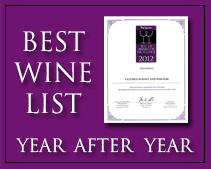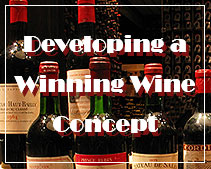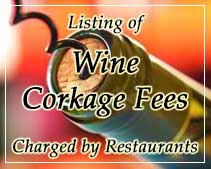Alsace Riesling has a national identity problem
February 15, 2011
Another French Paradox: Alsace Riesling
Everyone is familiar with the French Paradox: the French eat a diet rich in fat, but have a low rate of heart disease. Another French paradox is why Alsace Riesling is not more popular in the United States. By all rights, it should fly off the shelves.
Riesling, especially from Alsace, is the single most versatile food wine. When in doubt about what wine to serve with a meal, Riesling always works. What’s more, Alsace Riesling is the only top-quality French wine to carry a grape name-the form of labeling most familiar to American consumers-and the wines are reasonably priced. You can find great ones, such as Trimbach’s Cuvée Frederic- Émile, for $35 a bottle, and many ‘entry-level’ ones for $12 to $15 a bottle.
One explanation is that Alsace Riesling has a national identity problem. Many consumers wonder whether it’s German or French. The tall green slender bottles evoke images of sweet German Riesling in the American consumer’s mind. Séverine Beydon-Schlumberger (who, with her uncle, currently runs Domaines Schlumberger, an excellent Alsace producer), attributes the lack of recognition of Alsace wines in general to geopolitical forces as the region passed back and forth between France and Germany often over the last 150 years. She notes that between 1871 and 1918, just the time when wines from Burgundy and Bordeaux were becoming famous throughout the world, wine from Alsace was left behind under German rule. The German government prohibited Alsace from producing a quality product so as not to compete with German wine. Even today, despite Alsace’s return to France after World War II, Séverine reports that even some French have told her they thought Alsace was in Germany.
Another explanation is the bewildering Alsace label. Although Alsace labels typically identify grape varieties, this simple, US consumer-friendly system has morphed into a sometimes overwhelming Burgundian-like complexity of vineyard, subplot and proprietary names.
Fortunately, the basic wines-which represent good value and are usually the consumers first introduction to Alsace-are still labeled solely by grape name. In 1975, the government identified vineyards, much like in Burgundy, capable of producing better wines. The first vineyard identified as Grand Cru (unlike Burgundy there are no Premier Cru vineyards in Alsace) was Schlossberg in the village of Kientzheim. Twenty five more vineyards were classified in 1983, followed by another 24 in 1992, for a total of 50 grand cru vineyards whose name, along with the grape variety and the words, Appellation Alsace Grand Cru Contrôllée, appear on the label.
Many producers make multiple cuvées, each labeled slightly differently, from the same Grand Cru vineyard. To make matters more confusing, over the last several years there has been an explosion of lieux-dits, specific vineyards with no official standing. These labels indicate a vineyard and grape name along with Appellation Alsace Contrôllée (as opposed to Appellation Alsace Grand Cru Contrôllée).
Some prestigious producers, such as Trimbach and Léon Beyer, rejected the Grand Cru system. Jean Trimbach insists that, for political reasons, the boundaries of Grand Cru vineyards were expanded to include parcels not worthy of that designation and that the soil types within each vineyard are too varied. Marc Beyer, current head of the eponymous firm, believes, “A true vineyard classification in Alsace would need 500 names.” Hence Trimbach and Beyer, among others, continue to use their traditional proprietary names, such as “Cuvée Frederic Émile” and “Comtes d’Eguisheim,” respectively, for Riesling made from grapes grown in Grand Cru vineyards.
My short-cut remedy for understanding the label in Alsace is similar to my advice for understanding Burgundy: Find and remember the producer whose house style you like.
To my mind, the biggest impediment to more widespread popularity of Alsace Riesling is a lack of an identifiable style that can be generalized across the region. When consumers buy Marlborough (New Zealand) Sauvignon Blanc, they know what to expect. But Alsace Riesling comes in diverse forms-from Trimbach’s enamel-cleansing ones to the more voluptuous-and sweeter-examples from Weinbach.
When a consumer selects a Riesling expecting dryness and gets sweetness, it is far more jarring that getting an oakier Chardonnay than you bargained for. Jacques Sipp, winemaker at Sipp-Mack, notes, “You have to make an effort and know your Riesling. The sweetness confuses people so they order Pinot Blanc to be safe.” But it’s worthwhile to make that effort, according to Sipp because ” the value of Riesling is that its jungle of tastes never bores you.”
Jean Trimbach is adamant that the range of sweetness costs Alsace customers. If consumers try a Riesling that is surprisingly sweet, they “will not buy another bottle’ and as a result that consumer ‘is lost for Alsace.” Beyer believes that this is a problem that all Alsace growers need to over come. He has heard of more than one consumer reject Alsace wines in general because their first bottle was sweeter than they had expected.
Listing the residual sugar on the label would not help the consumer because it is the balance and interplay between acid, richness of flavor and sugar that conveys sweetness. Two wines with the same residual sugar will differ in sweetness on the palate depending on the levels of acidity. A relative ‘sweetness scale’ might be helpful, but would be a kiss of death in the US market for any wine not described as “dry.”
It matters little that wines with a hint of sweetness are the perfect match for spicy, Asian fare and other full flavored dishes. Moreover, most producers’ best Riesling, those from Grand Cru vineyards, contain slightly more residual sugar than their basic ones. The wines’ richness, which comes from the superior vineyard site, is balanced by all the other elements.
Nonetheless, sweetness in wine has such a pejorative connotation among US consumers that it affects marketing. Möet & Chandon avoided any reference to sweetness when they introduced their White Star Champagne to the US market. Too sweet to be labeled Brut, Moet & Chandon wisely decided against labeling it as Extra-Dry (which is, paradoxically, sweeter than Brut) and just omitted any reference to level of sweetness on the label. Despite Americans’ voiced desire for dry wine, White Star is now the top selling Champagne in the US.
The way to avoid surprises when buying Alsace Riesling is to know the producer, just as in Champagne, Burgundy, or other fine wine regions. For example, all of Trimabch’s Rieslings (from their entry level bottling labeled simply as Riesling, to their Riesling Reserve, to Cuvée Frederic-Émile, to their exquisite Clos Sainte Hune) are stylistically similar, with a racy, fresh style invigorated with very energetic acidity. They are at their best with food, being a bit grating for aperitif purposes for many tasters. Close to the other end of the spectrum are the wines from Domaine Weinbach or Domaines Schlumberger, whose Rieslings are fleshier and softer and could be consumed before a meal as well as with it.
One style is not “better” than another. Since most Alsace Rieslings are well-made and distinctive, subjective enjoyment comes down largely to personal preference and a correspondence between expectation and product. The situation is analogous to Champagne, where wine style differs from house to house but quality is generally quite high and prices are fairly uniform. Sure, Bollinger is full-bodied while Taittinger is notably lighter, but both make lovely wines within their particular stylistic template.
The key to enjoying Alsace Riesling-like Champagne-is knowing which producers make the style you prefer.
Jacques Sipp, who knows the American market well (he’s married to an American and has worked in a Texas winery) puts it nicely, “There are over 1,000 different families in Alsace making Riesling. There is a mosaic of a hundred villages and soils. The wines range from sweet to dry. Riesling is interesting in all its different styles; you just have to be prepared for the style you are getting.”
To help the uninitiated explore the delights of Alsace Riesling and navigate “the jungle of tastes” that Jacques Sipp treasures, I have attempted below to categorize producers’ style based on a spectrum of richness or sweetness. This guide is certainly not comprehensive, but includes a sampling of producers whose wines are likely available in diverse markets.
There are several important caveats:
1) Vintage plays a large role. Everyone made riper wines in 2003-but position on the spectrum remains similar in comparative terms. Although riper than usual, Trimbach’s 2003s are still significantly leaner than Schlumberger’s 2003s.
2) Similarly, vineyard location is critical. (Even Jean Trimbach, whose family firm exemplifies the dry style of Riesling, agrees that wines from Grand Cru vineyards will always have a touch more residual sugar). Nonetheless, comparing grand cru to grand cru, the producer’s relative position on the spectrum of richness remains constant.
3) Aged wines always taste drier than young wines, and that makes a difference in this category, since good Grand Cru Riesling takes several years to open and will continue to develop for a decade or more. I can’t explain what happens to the sugar; I suspect it undergoes a chemical transformation such that it is no longer capable of stimulating the taste buds that recognize sweetness.
4) Admittedly, house style is not fixed in stone. For example, Weinbach’s Rieslings, while still opulent, seem to be more tightly wound in recent years. Nevertheless, house style remains the best guide to selecting Alsace Riesling.
Source: http://www.winereviewonline.com/ma_on_alsace_riesling.cfm
The wine shop in Angeles Philippines Clark Freeport Zone Pampanga as well as other wine shops, wine bars and wine outlets in Subic and Manila are wells stocked with interesting selections of RIESLING wine from many vintages spanning over 90 years from various producers covering a wide range of prices.
As a wine collector, hobbyist or someone in the wine trade, are you concerned or interested about this also? If so, please stay tuned in to Yats Wine Cellars’ web site to stay abreast of things to do with wine in the world.
News and pertinent information about wine trade, wine appreciation, wine shops and outlets, wine and food pairing, wine making, viticulture, vintages, climate conditions affecting wine, new and revived wine regions etc can be found here in this section. Yats wine Cellars is much more than a Philippines wine supplier with a few wine shops, wine bars and wine outlets in Philippines where clients can buy good wines in Manila, Angeles City, Subic and Clark Philippines. Yats Wine Cellars is also a rich source of information for the convenience of the growing community of wine lovers, wine connoisseurs and hobbyists. Wine lovers in Manila, Subic, Angeles City, Clark Philippines can enjoy fine vintage wines in any of Yats Wine Cellars wine shopping outlets, wine bars, wine shops and wine restaurants.
You are welcome to post your comments and questions about any topic related to wine on www.YatsWineCellars.com or email Wine@Yats-International.com with your comments, suggestions, questions, purchases or inquiries on wine and wine-related topics.
Leading Philippines Wine Supplier Yats Wine Cellars based in Clark Philippines with outlets in Angeles City, Subic Freeport and Manila Philippines has been not only a wine shop for fine wines covering all major wine regions but also a source of reliable and useful information about wine, wine appreciation, wine accessories, wine and health, food and wine pairing and all other matters relating to wine and its appreciation. This Philippines Clark Freeport based Wine Supplier and Wine Shop frequently holds public wine tasting events in Pampana Clark Freeport Zone, Angeles City, Subic Bay area, Makati, Fort Bonifacio and other areas in Philippines capital city Manila. Private Wine events such as private wine tasting and private wine dinners are also designed and organized for private clientele for their wine loving guests.
Wine Catering is a unique product of Yats Wine Cellars, created back in 2005 in response to a growing demand for private wine parties in Manila, Cebu, Subic, Angeles Clark Philippines.
Chateau Lafite-Rothschild is the most revered wine in China and many other parts of Asia. The best wine shop in Asia to buy older vintages of Chateau Lafite is Yats Wine Cellars located in Clark Philippines. Aside from Lafite, visitors can buy other fine wines at this wine shop in Clark Pampanga such as Latour, Mouton-Rothschild, Haut-Brion and Margaux. Excellent Burgundy wines like Chambertin, Vougeot, Musigny, Bonnes Mares, Pommard, Meursault, Chambertin, Vosne Romanee, Romanee Conti, La Tache and Romanee St. Vivant can be found here.
Yats Wine Cellars can be reached at their Clark Wine Center Philippines wine shop located on the main highway M A Roxas of Pampanga Clark Freeport Zone or their sales office in Ortigas Centre, Metro Manila. Here is the contact information:
Clark Wine Center
Bldg 6460 Clark Observatory Building
Manuel A. Roxas Highway corner A Bonifacio Ave,
Angeles Clark Freeport Zone, Pampanga 2023
0922-870-5173 0917-826-8790 (ask for Ana Fe)
YATS Wine Cellars
Manila Sales Office
3003C East Tower, Phil Stock Exchange Center,
Exchange Rd Ortigas Metro Manila, Philippines 1605
(632) 637-5019 0917-520-4393 ask for Rea or Chay
Best place to buy wine in Clark Pampanga outside Manila near Subic and Angeles City Philippines is Clark Wine Center.
Wedding couples looking for wedding reception venues and beach wedding venues can log on to this Philippines Wedding Venue web site for free information and assistance:
http://www.PhilippinesWeddingVenue.com
While in Clark, it might be a good idea to enjoy an evening of wine-and-dine in the fine dining Yats Restaurant and Wine Bar that features an award winning 2700-line wine list. It is located in Mimosa Leisure Estate of Clark Freeport Zone. For more information, visit http://www.YatsRestaurant.com
YATS Leisure Philippines is a developer and operator of clubs, resorts and high-class restaurants and wine shops in Clark Angeles Philippines http://www.yatsleisure.com
Looking for famous tourists spots, places to visit and see, relax and unwind in Clark, Pampanga, Philippines? You may want to check out these sites also:
http://www.HotelClarkPhilippines.com
http://www.ClarkPhilippines.com
http://www.YatsWineCellars.com
You can skip to the end and leave a response. Pinging is currently not allowed.







